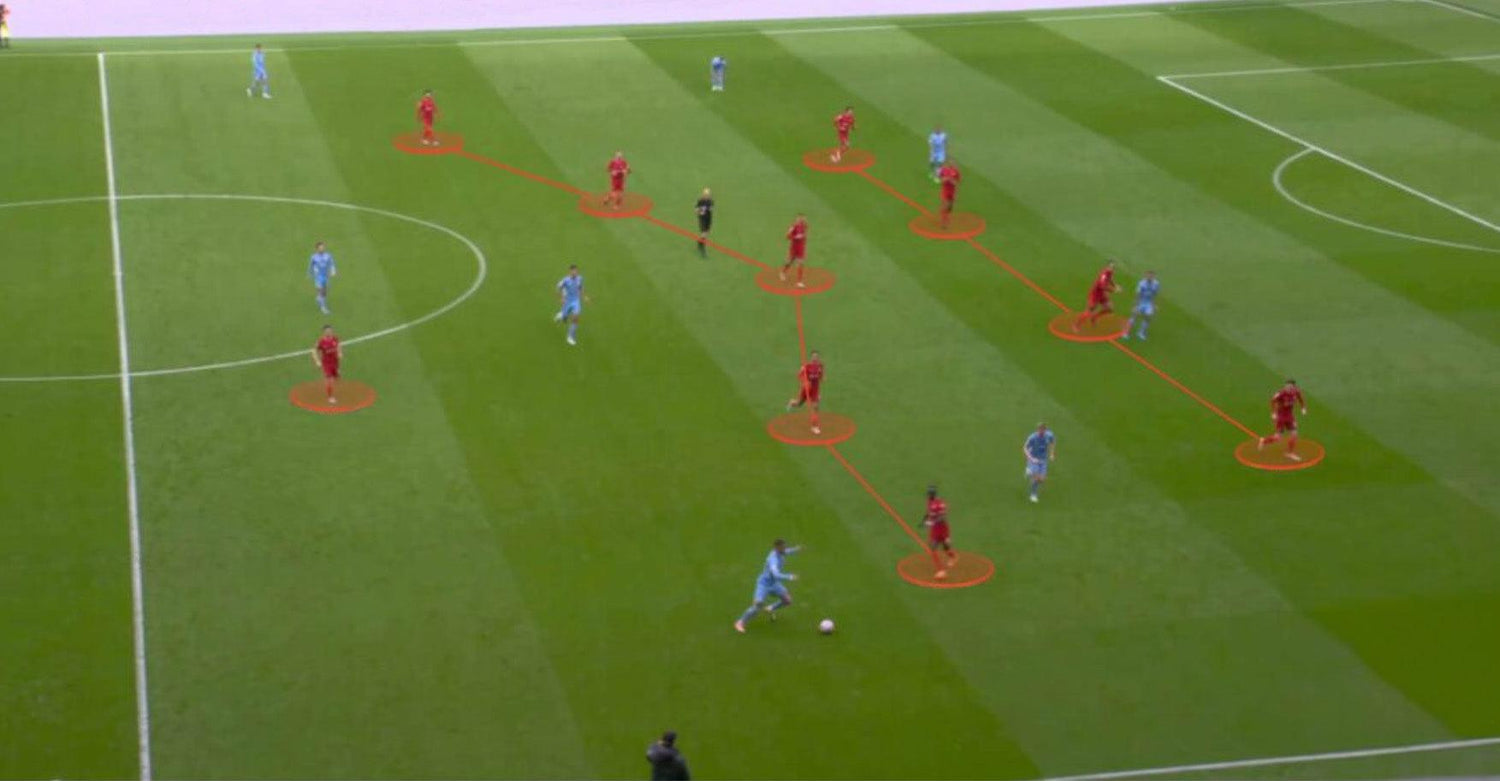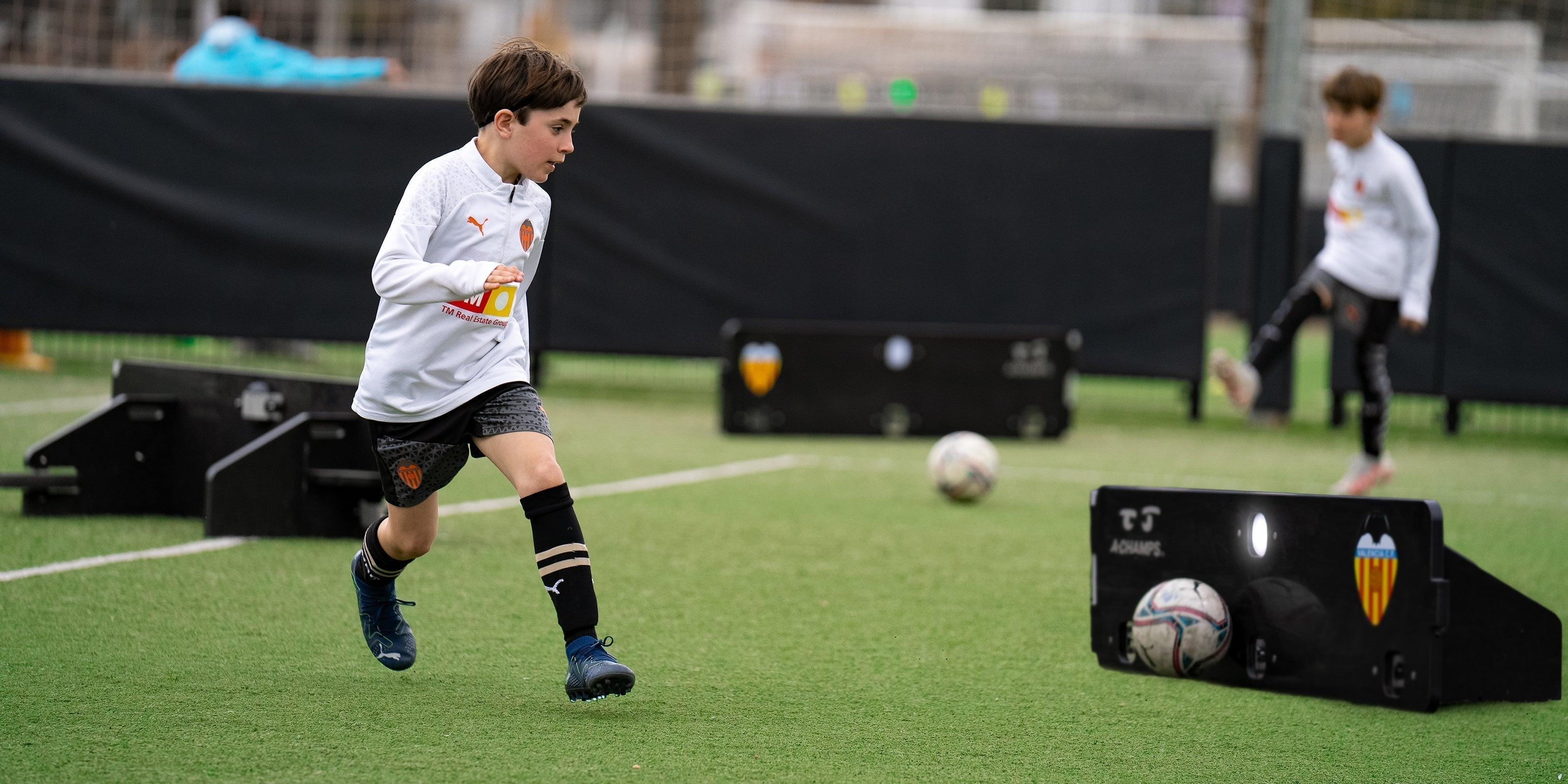Die 4-5-1-Formation ist eine strategische Kraft im Fußball. Sie ist darauf ausgelegt, das Mittelfeld durch eine Mischung aus defensiver Stabilität und offensiver Flexibilität zu dominieren. Diese Formation besteht aus vier Verteidigern, fünf Mittelfeldspielern und einem Stürmer und ist daher ideal für Teams, die das Zentrum des Spielfelds kontrollieren und nahtlos zwischen Defensiv- und Offensivphasen wechseln möchten.
In diesem Leitfaden gehen wir auf die Feinheiten der 4-5-1-Formation ein, auf ihre Ursprünge, ihre Verantwortlichkeiten mit und ohne Ballbesitz und die Vorteile, die sie bietet.
Entwicklung und Ursprünge der 4-5-1-Fußballformation
Die 4-5-1-Formation hat ihre Wurzeln in der 4-3-3 - Formation , weist jedoch deutliche Unterschiede in der Positionierung der Außenmittelfeldspieler und des zentralen Mittelfelds auf. Die Flügelspieler in einer 4-5-1-Formation spielen tiefer und bilden eng mit den drei zentralen Mittelfeldspielern eine kompakte Fünferkette. Diese Anpassung verwandelt die Formation in eine robuste Defensivstruktur, wobei die Flexibilität erhalten bleibt, bei Ballbesitz in ein offensiveres 4-3-3 oder 4-1-4-1 zu wechseln.
Historisch gesehen gewann die 4-3-3-Formation an Bedeutung, als Brasiliens Mannschaft bei der Weltmeisterschaft 1958 ihr 4-2-4-System adaptierte, das später zu einer flacheren Mittelfeldlinie weiterentwickelt wurde und schließlich im defensiv ausgerichteten 4-5-1 gipfelte.
Viele Spitzenteams haben diese Aufstellung genutzt, um eine starke Verteidigungsposition einzunehmen und gleichzeitig die Fähigkeit zu behalten, wirksame Gegenangriffe zu starten.
Aufgaben in der 4-5-1-Formation
Verantwortlichkeiten im Besitz des Spielers
Bei Ballbesitz verwandelt sich die 4-5-1-Formation oft in eine 4-1-4-1- oder 4-3-3-Formation, wobei der Schwerpunkt auf Flexibilität und Unterstützung liegt. Der einzige Stürmer ist entscheidend, da er den Ball hält und das Spiel mit den vorrückenden Mittelfeldspielern verbindet. Das zentrale Mittelfeldtrio , insbesondere die Achter , geht mit durchdringenden Läufen in die Offensive, während die Außenmittelfeldspieler entweder nach vorne drängen , um Breite zu schaffen, oder nach innen ziehen , um Torchancen zu kreieren.
Die Außenverteidiger spielen eine entscheidende Rolle bei der Unterstützung der Mittelfeldspieler. Sie können entweder überlappen , um Flanken zu schlagen, oder nach innen ziehen, um zusätzliche Passoptionen zu schaffen. Diese fließende Bewegung ermöglicht es dem 4-5-1, sich dynamisch an den Spielfluss anzupassen, den Ballbesitz zu behalten und reibungslos zwischen Abwehr und Angriff zu wechseln .
Verantwortlichkeiten außerhalb des Ballbesitzes
Defensiv zeichnet sich das 4-5-1 durch Kompaktheit und Druck aus. Der Mittelstürmer leitet den Druck ein und lenkt das gegnerische Spiel auf die Flanken , wo die Außenmittelfeldspieler und Außenverteidiger den Ball festhalten und zurückerobern können. Das zentrale Mittelfeldtrio sorgt für Raumdeckung , blockiert Passwege und unterstützt den Vorwärtsdruck.
Die Viererkette bleibt kompakt und verlagert sich seitlich, um auf die Bewegung des Balls zu reagieren. Gleichzeitig ist sie bereit, bei Bedarf zurückzufallen oder aufzurücken. Wie Sie sehen, ist die 4-5-1-Formation eine disziplinierte Struktur , die sicherstellt, dass die Mannschaft gegnerische Angriffe abwehren, effizient in Ballbesitz kommen und Konter starten kann.
Vorteile der 4-5-1-Formation
Die 4-5-1-Formation bietet mehrere strategische Vorteile:
- Dominanz im Mittelfeld : Mit fünf Mittelfeldspielern sorgt das 4-5-1 für eine zahlenmäßige Überlegenheit im Zentrum, was es für die Gegner schwierig macht, das Spiel durch die Mitte aufzubauen.
- Defensive Stabilität : Die kompakte Mittelfeldlinie bietet der Verteidigung hervorragenden Schutz, verringert das Risiko einer Unterzahl in den zentralen Bereichen und erleichtert das Blocken von Schüssen und das Abfangen von Pässen.
- Flexible Übergänge : Die Anpassungsfähigkeit der Formation ermöglicht schnelle Übergänge zwischen defensiver und offensiver Formation und ist daher für verschiedene Spielsituationen und taktische Anpassungen geeignet.
- Konterpotenzial : Die Außenmittelfeldspieler und Achter sind gut positioniert, um Räume bei Kontern auszunutzen, den einzigen Stürmer zu unterstützen und Torchancen zu kreieren.
Nachteile der 4-5-1-Formation
Trotz seiner Stärken weist die 4-5-1-Formation gewisse Einschränkungen auf:
- Angriffsunterstützung : Der einzelne Stürmer kann isoliert werden und benötigt wirksame Unterstützung durch Mittelfeldspieler, um den Angriffsdruck aufrechtzuerhalten und Chancen zu kreieren.
- Flügelabhängigkeit : Der Erfolg bei Kontern hängt stark von den Außenmittelfeldspielern ab, deren defensive Aufgaben ihren offensiven Beitrag manchmal einschränken können.
- Ballbesitz : In einem 4-5-1-System kann es aufgrund der flachen Mittelfeldlinie schwierig sein, den Ballbesitz zu behalten. Um Ballverluste zu vermeiden, sind präzise Pässe und Bewegungen erforderlich.
Beispiele für Teams, die die 4-5-1-Formation verwenden
Mehrere Spitzenteams und Trainer haben die 4-5-1-Formation erfolgreich umgesetzt:
- Jürgen Klopps Liverpool : Liverpool ist für sein aggressives Pressing und seine offensiven Übergangsphasen bekannt und nutzt das 4-5-1-System, um einen kompakten Abwehrblock aufrechtzuerhalten und seinen Flügelspielern gleichzeitig die Möglichkeit zu geben, Räume bei Kontern auszunutzen.
- Eddie Howes Newcastle United : Howes Newcastle hat einen 4-5-1-Mittelblock eingesetzt, wobei die Außenmittelfeldspieler zur defensiven Unterstützung und zum hohen Pressing eingesetzt werden, wodurch das Spiel des Gegners effektiv gestört wird.
- Gennaro Gattusos Napoli : Unter Gattuso sicherte sich Napoli mit einem disziplinierten 4-5-1 den Titel im Coppa Italia, wobei defensive Stabilität mit flüssigen Angriffsbewegungen in Einklang gebracht wurde.
- England unter Gareth Southgate : Southgates England bevorzugte einen 4-5-1-Mittelblock und nutzte die Kompaktheit dieser Formation, um die zentralen Bereiche zu kontrollieren und schnelle Angriffe durch vielseitige Mittelfeldspieler zu starten.
Verbesserung des 4-5-1-Fußballformationstrainings mit A-Champs-Tools
Um die 4-5-1-Formation effektiv zu trainieren und zu meistern, kann der Einsatz innovativer Trainingsgeräte wie denen von A-Champs die Leistung deutlich steigern. Unsere Tools bieten eine Reihe hochtechnologischer, interaktiver Trainingsgeräte, die die Wahrnehmung, Entscheidungsfindung, Reaktionsgeschwindigkeit, Ausführung, Beweglichkeit, Koordination und Ballkontrolle der Spieler verbessern – allesamt entscheidende Faktoren für die dynamischen Anforderungen der 4-5-1-Formation.
- A-Champs ROX System : Dieses System nutzt kabellose, leuchtende Pods, die in verschiedenen Konfigurationen angeordnet werden können, um reale Spielsituationen zu simulieren. Dieses Tool eignet sich perfekt für das Training der kompakten und flüssigen Bewegungen, die in der 4-5-1-Formation erforderlich sind. Spieler können an ihrer Positionierung, ihrer schnellen Entscheidungsfindung und ihrer Koordination arbeiten und so einen nahtlosen Wechsel zwischen defensiven und offensiven Rollen gewährleisten.
- Interaktive Übungen : Durch die Integration der interaktiven Übungen von A-Champs in Ihr Trainingsprogramm können Spieler ihr räumliches Bewusstsein verbessern und ihre Fähigkeit verbessern, im Mittelfeld kompakt zu agieren. Diese Übungen sind für zentrale und äußere Mittelfeldspieler unerlässlich, um ihre Aufgaben mit und ohne Ballbesitz effektiv zu erfüllen.
- Reaktionstraining : Die 4-5-1-Formation basiert oft auf schnellen Umschaltmomenten und Kontern. Die A-Champs-Tools helfen Spielern, schnellere Reaktionszeiten zu entwickeln und ihre Fähigkeit zu verbessern, Druck auszuüben und schnell den Ball zurückzuerobern. Dies ist besonders vorteilhaft für den alleinigen Stürmer und die Mittelfeldspieler, die agil sein und auf wechselnde Spieldynamiken reagieren müssen.
Der Einsatz der A-Champs-Tools erweitert das traditionelle Fußballtraining nicht nur um eine technologische Weiterentwicklung, sondern sorgt auch dafür, dass die Spieler besser auf die körperlichen und geistigen Anforderungen der 4-5-1-Formation vorbereitet sind .
Abschluss
Die 4-5-1-Formation ist ein Beweis für die strategische Tiefe und Anpassungsfähigkeit , die im modernen Fußball erforderlich ist. Durch die Beherrschung dieser Formation können Teams ein Gleichgewicht zwischen defensiver Belastbarkeit und offensiver Stärke erreichen, was sie zu einer wertvollen Ergänzung für das taktische Arsenal jedes Trainers macht. Weitere Einblicke in Fußballformationen und Trainingstechniken finden Sie in unseren ausführlichen Anleitungen zu verschiedenen Formationen und ihren taktischen Feinheiten.
Weitere Informationen zu Abwehrformationen im Fußball finden Sie in unserem umfassenden Blog über verschiedene Abwehrformationen und ihre strategische Anwendung.





Hinterlasse einen Kommentar
Diese Website ist durch hCaptcha geschützt und es gelten die allgemeinen Geschäftsbedingungen und Datenschutzbestimmungen von hCaptcha.